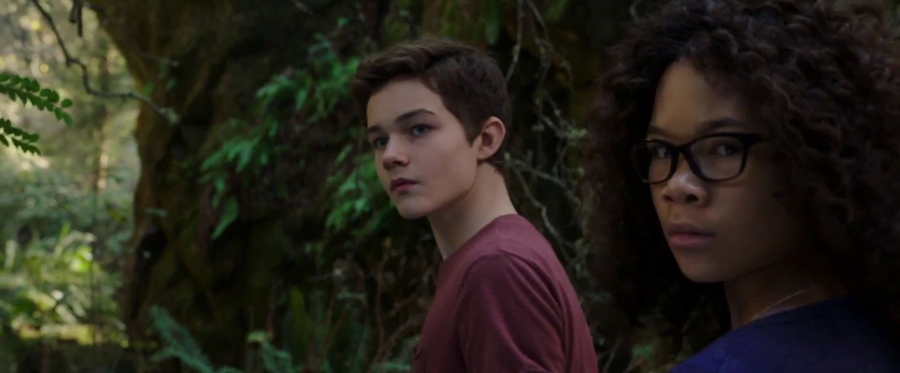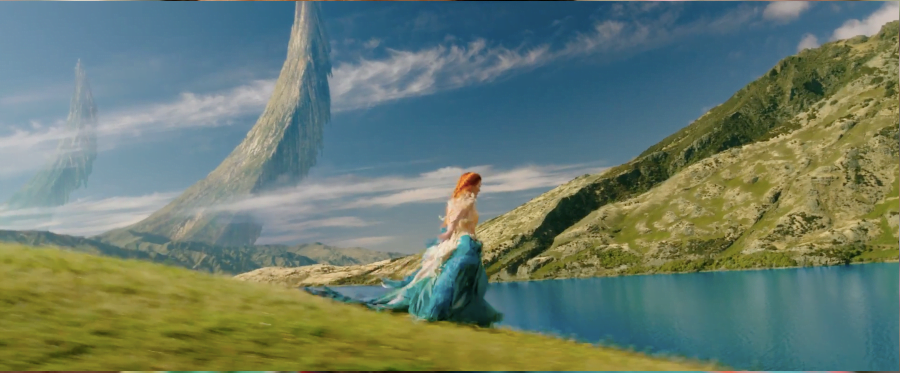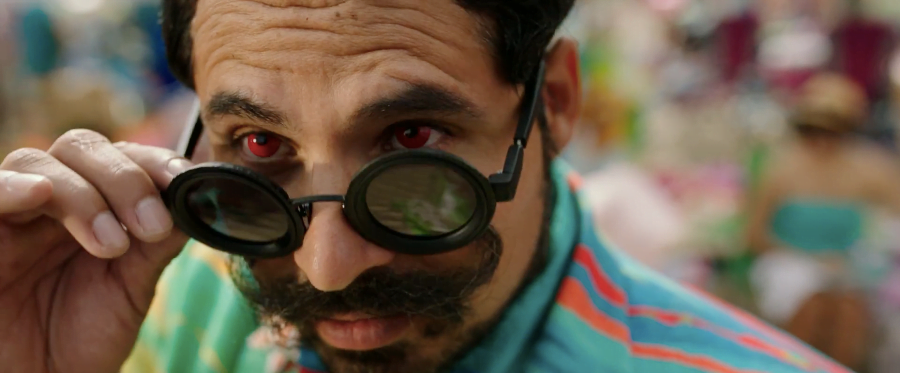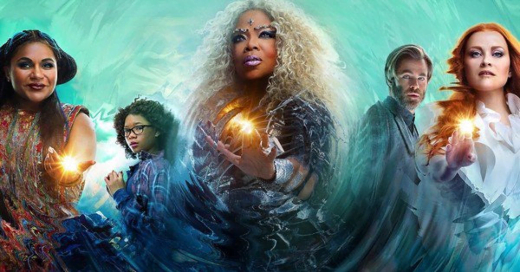When A Wrinkle In Time’s trailer dropped it did so with the immense thud of someone on the other side of a backyard fence raising their voice and now suddenly, the whole neighbourhood gets to be part of this conversation that has been going on for years and is not going to end tonight no matter how much you wish it would. It was like a Discourse Bomb, a sudden and dramatic arrival of a conversation that was both in progress and extremely sophisticated, and it absolutely did not need me.
There was talk about the trailers, about the importance of Oprah as a goddess figure, about the race casting in the books and the movies, about the importance of the work as autistic art, about the intense significance with which people could dismantle scene by scene in the book and how a movie could never manage to express the quantum and fractal nature of the narrative, how Oprah didn’t deserve a role, comparisons to Black Panther for girls and hang on is that meant to say that girls can’t enjoy Black Panther and about how being mean to a billionaire never hurt them, and so on and so on and this was, again
when the trailer dropped.
Now imagine this trailer was literally the first time you ever heard anything at all about this book series or why it was important.
Unpacking what I thought about this movie has taken some time and part of the problem with that unpacking is that largely, I feel like I must have either a very surface reading of it, or I must not understand the contentious issues, because I thought it was really good and I hope other people get a chance to enjoy it without being slurped into that conversation like some kind of eldritch transport system.

The story of Wrinkle In Time is a pretty standard one; we have a smart kid alienated from the ordinary life in which they are bullied over a variety of things that include the absence of their famously mockable father, discovering that the world they live in is part of a much bigger world, discovering new things about themselves, and going on an adventure to fantastic and wonderful places to find what was lost and stop a dreadful thing they only discover as part of this journey. It’s a classic story structure and I like it for that because it means that you’re not spending your time trying to keep intricate plot details in order, you’re instead focusing on how these characters interact with this space and one another.
What sets it apart from this extremely standard template, though is that the main character, Meg Murray, is not an only child who retreats into flights of fancy ala The Typical Boy version of this story, but also she’s black (and biracial to boot, but I didn’t ‘get’ any of that watching this movie). Meg is the older sister of Charles Wallace, a very intelligent kid who acts in socially inappropriate ways, and the adventure to find her father is both enabled by his ability to see what’s really present rather than dismiss it as impossible, and complicated by the way he interacts with people.
Rather than just populate its world with the blanket catch-all of magic like a Narnia or a Harry Potter story does, A Wrinkle In Time sets itself up as part of a world of possible wonders, of things that could be, beyond our understanding of quantum physics, which gives a sort of super-science feeling to everything. Kind of.
That’s all kinda basic, though; it’s an adventure story but, and it’s a fantasy story and it’s a quantum sciences story except.
If all you want is the basic ‘hey, should I check this out?’ I think you should. It’s a neat movie, it’s got some good bits to it, it’s on streaming services so it’s very convenient to, and as a movie, it’s just shy of two hours and is full of a lot of lovely visual spectacle. But if you have seen it and you want to know why I liked it, well, let’s go on with that from there.

First things first, there’s a lot of stuff in this story that’s about knowing.
In a lot of these kind of fantasy adventure stories, the main character gets some special dispensation that’s usually related to doing or being. Doing stories are often about finding a thing the character already wants to do and just finding an outlet for that – you can find a lot of Doing stories in the plucky sports team genre. The Mighty Ducks story is mostly about Doing, about characters who all already have a thing they can do and then the story is about getting them to a place where they do the thing and it’s the best thing to be doing. Lots of stories about destined children, or royal heirs, those are stories about being – every Disney Princess story in a lot of ways is a being story.
But Wrinkle in Time is a story about knowing. It’s expressed in the most basic way about the tesseract travel they can do – where it’s not a matter of mixing formula pieces together or creating some mystic device, it’s just a matter of if you know how to tesseract, you can do it, and the doing is in the knowing. There are a lot of word actions in our world, where just saying a thing is performing an action, and the world of Wrinkle in Time is one where what you say is what you do.
It’s also a story where the enemy relies on the enemy not being known; IT changes the way people behave, and that makes things worse, but when you understand IT is doing it, the actions stop being about being in a world that’s cruel and become more about seeing people around you tormented by IT. IT wants you to think the world is like it, but the world is only like IT when it is making it that way. When you know, it changes what you see.
Another thing about this that I love is that it really condenses a lot of fantasies into a very approachable, handleable thing. As a kid, the fantasy that the cruelty created by differences in class and social standing and race is just a thing that you can find, and reject, and in rejecting it, end its power, that’s a potent one, and it also serves to inform the way that racism and sexism and all these things aren’t just these things contained in people, they’re these big external systems that need to be opposed.
The movie is rich with extremely obvious metaphor, and that sounds like a contradiction but it’s beautifully woven. Everything is an extremely obvious version of its idea but realised with a lot of visual effort, a sort of scale that makes the simplicity of the metaphor remarkable and impressive all over again. The metaphors are graspable by a child but the scope of them is so massive that it’s beautiful to behold.

There’s other stuff as well. There’s a little note that all the actresses and actressors in this came to do work, with particular note to Storm Reid who has to carry whole scenes on her shoulders as a kid who is both feeling things very hard and actively working to keep that hidden. There’s a lot of difference between looking like you’re not feeling things and looking like you’re trying to look like you’re not feeling things, and particularly the moment when Meg hucks a ball at her bully there’s a real sharp switch from fine fine fine to FUCK YOU that’s really excellent.
Also, Michael Peña (who I liked already) and Chris Pine (who I didn’t) both do great turns as well, and the rest of the cast is mostly made of people who are unsurprisingly excellent. Oprah has to stand up and act like the most important magnanimous thing in the room, which at the very least, we can be sure she’s got practice doing. Deric McCabe plays Charles Wallace, the younger sibling of Meg, and while I’ll defer to other voices on this, I have the impression the kid he’s meant to be playing is on the autism spectrum in some capacity. If that’s intentioned and appropriate, that’s pretty impressive work from a child actor.
There is one final thing, one thing about the Great Discourse around this movie that I don’t want to talk too much about because I’m not really an expert, but there’s this bit at the end where Meg is presented with an alternate version of herself, a temptation of the classical villainous style. “Join me and I’ll give you stuff I want.” The visual she’s presented with is herself, of course, but one detail about her is that her hair is straight and smooth.
I am not an expert in blackgirlness. But I know this much: The territory of black girls’ hair is fraught with politics and power and the cruelty of people in demanding one standard be met or another. And the ability to show Meg with one of two different styles of hair has an enormous weight compared to if Meg had been presented as a white kid to start with. Yes, you can do different hairs on white girls too – but there’s no white girl hair style that can contrast in the same way, have the same simple, instantaneous visual impact of what a self-image shift can mean to a black girl. It’s an example of the kind of visual storytelling you can do when you include more people’s voices in your work, when you reach wider and diversify how you make stories.
In the end, this movie feels like a really good iteration on the idea of those Meaningful Movies About Being A Kid And Growing Up like The Neverending Story. I hope kids who get to see it enjoy it, and I hope adults who go with them have fun too.
